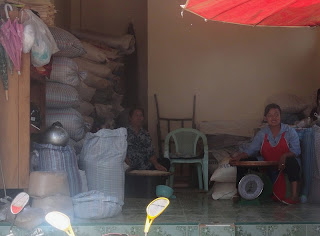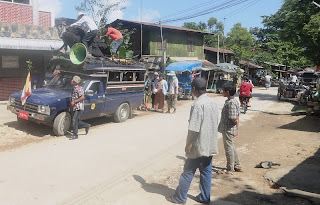This post has a lot of photographs, most of which are not very great as far as lighting is concerned. It was on this portion of our trip when I realized Christopher changed the settings on my camera. I wasn't able to fix it right away so some of these photos have a funky glare or blast of light. Unfortunately, I am not experienced with photoshop and couldn't fix them beyond the "auto adjust" on my computer program.
On our last "full" day in Chiang Rai, we arranged to hire a guide and a car & driver to go to both Myanmar and Laos for the day. Before we left the hotel, Christopher was able to ride one of the water buffaloes that the hotel keeps to work in its rice paddies and gardens. You can barely see our guide, Anan, in the bright blue shirt in the photo below.
This is our driver waiting for Christopher's ride to end.
It was about a 40 minute drive north of the hotel to Thailand's border with Myanmar near the town of Mae Sai. The border crossing was a very narrow and short bridge over a canal. On one side of the bridge was the Thai immigration/customs office and on the other side was Myanmar's.
In Myanmar, they drive on the "right" side of the road (like in the US) so, when crossing over the bridge, once you enter the other country, you must immediately switch over to the other lane. The fact that you do this exactly midway across the bridge doesn't seem to faze anyone. It looked a little crazy but everyone ended up where they were supposed to be.
We entered Myanmar without a problem but it was a little disconcerting as the immigration office kept our passports for the time that we were in Myanmar. They did give us a "temporary" entrance document but not having our diplomatic passports (which I consider my ticket out of any kind of trouble!) made me very uneasy. After crossing the border, Anan took us to a "local" food market that was set up in some back streets of the village. The ladies in the photo below are selling rice - you can see the scale and the bags of rice in the background.
One of the stalls that sold fresh fruit.Bags of chili peppers for sale.
A vendor with her fresh produce.
A look down the street into the market.
A vendor selling chili peppers and ginger.
This vendor was selling different kinds of spices and herbal goods. In the two bowls in front of him, you can see turmeric and paprika.
A basket of lemons.
Vendors selling fruits, vegetables and eggs.
The photo below is another look from down a street into the market. This section of the market had household goods, fabrics and clothing for sale.
The woman in the photo below was selling dried fish, dried shrimp and I don't know what else.
Now into the meat, poultry and fish section of the market. Try not to notice the unsanitary conditions. Trust me, after a while, you get used to it.
I love the photo below!
Just in case you wanted a closer look...
We bought a coconut from the woman in the photo below and she is cutting the top of the coconut off so we could put a straw in and drink the milk. These coconuts are first roasted in fire and the charred shell is then cut off so the coconut ends up looking like a carved wooden ball. The roasting gives the coconut milk a creamy texture and it has a very nice sweet and smoky flavor.
We finished at the market and then walked farther into the village to a temple. This temple was so incredibly large that I could not get a photo of the entire building. The temple has been under construction for many years (maybe 20?) as work is only done when money is available. Anan told me that I could take photos of the interior but there were several monks inside and I did not want to disturb their worship.
Also on-site was the residence for the monks and a school for boys training to be monks. Everyone lives in a dormitory-style building and communal meals are taken in a cafeteria.
Unfortunately, Christopher and I needed to use the bathroom and were shown to a block of these...
After our bathroom break, we went to the cafeteria to have a look around. Monks are only allowed two meals a day and are not allowed to eat anything after noon. More devout monks will only have one meal a day. All of the families in each village are responsible for providing the monks with their daily meals. The responsibility for feeding the monks is allocated differently in each village but the monks always get fed. Every morning, the monks walk through the village to collect the food for that day's meals.
The photo below shows the lunch plates filled and ready to be served.
As we left the temple, we noticed a truck parked across the street with a crowd around it. Two men were removing something from the top of the truck and we could hear loud music and singing.
The "something" that was taken off the pickup truck turned out to be a water buffalo costume worn by two men. Anan told us this was a group of villagers who were going to make a presentation and bring gifts to the temple. I am not sure what the water buffalo symbolized but it was quite an elaborate get up!
The group in the photo below followed the water buffalo down the street while singing and playing different kinds of instruments. It was just like a parade.
The photo below shows a group of village children watching the production. Click on the photo to enlarge it and take a closer look at the woman riding the moto on the right side of the photo. This is a common sight here but could you ever imagine doing that in the U.S.?
Next, Anan took us down a few streets in the village so we could see some local homes. The photo below is from the bottom of the street looking up.
As soon as we started walking up the street, all of these children (about 10 -12 years old) suddenly came out of the woodwork and gathered around us, trying to sell us homemade crafts and little knick knacks. Anan told us that, in order to make a living, the grandmothers make the crafts and the children sell them to tourists. After hearing that and seeing their living conditions (sob sob), Caitlynne and I bought two embroidered and beaded handbags from a little girl. However, as we continued to walk up the street, we happened to go by a home with the front door wide open. Being the nosy person that I am, I looked in and saw a television that was about twice the size of ours! I guess selling crafts to tourists is a pretty good business to be in.
The women in the photo below sold us some "sticky corn". This is a specific type of corn that is steamed inside its husk, the husk is then peeled off and the corn is eaten off the cob. It had a sweet taste and but it was the mushy texture that I just couldn't get past.
At the top of the street, we could look out over the village. Kevin commented on the large number of television antennas on the homes and Anan told us this village got electricity only two years ago!
Our next stop was at a large temple. This temple was interesting in that there were 7 stations (one for each day of the week) set up around the exterior of temple's base. According to Buddhist teachings, if you pray and perform a ritual at the station for the day of the week on which you were born, you will receive a special blessing from your patron spirit. One of the guides had a book to help us figure out the days we were born on. Christopher was born on a Tuesday, Kevin on a Thursday and Caitlynne and I both on a Saturday. It was quite funny (well, really only to me) because the last time Kevin and I saw Jimmy Buffet in concert, it was during his "Tuesdays, Thursdays and Saturdays" tour. No one else shared my excitement over this coincidence though.
Thank goodness Anan was with us to explain the process of the ritual. Each station has a statue of your patron spirit at the highest level. There is a reclining Buddha on the level below the spirit and then, on the lowest level, a statue of your spiritual animal.
First you pray...
And then you pour holy water over the Buddha...
And then pour holy water onto the hands of your patron spirit...
And, lastly, you pour holy water over your animal spirit on the lowest level. Somehow, I did not get a photo of Kevin doing this last step but you can see Caitlynne, Christopher and I doing it in the photos below.

Kevin's patron animal spirit was the lion (leadership, honor and strength), Caitlynne and I had a dragon (philosophical, understanding, prefers to work alone because we do not like depending on others to get the job done) and Christopher's was a rat (intelligence, focus and stubbornness). It was a very interesting experience, that was for sure!
Next, we moved on to a very large market that sold every counterfeit item you could imagine. Handbags, watches, cigarettes, shoes, sneakers, etc. The leather, construction, hardware, stitching, etc. was of extremely high quality and it would take a very experienced shopper to be able to identify the knock offs. In fact, Caitlynne and I practically tore a Louis Vuitton purse apart trying to find evidence of it being a fake.
After the market, it was early afternoon and time to go back to Thailand for the second part of our trip (to Laos).
I am going to break here for today and will continue tomorrow with the Laos portion of our trip.
Have a great day everyone!



















































1 comment:
I love the posts about your trip! You guys are all getting such a wonderful experience!
Post a Comment